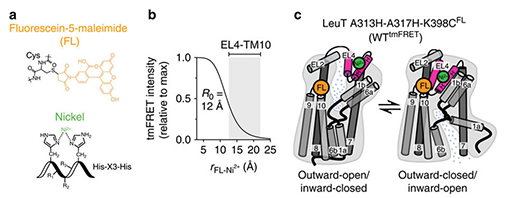New neuropharma-synbio publication on the regulation of neurotransmitters
LeuT is a model target protein for antidepressants and psychostimulants. Measurements by FRET revealed the ability of K+ to regulate the LeuT transport cycle
Transition metal ion FRET uncovers K+ regulation of a neurotransmitter/ sodium symporter. Christian B. Billesbølle, Jonas S. Mortensen, Azmat Sohail, Solveig G. Schmidt, Lei Shi, Harald H. Sitte, Ulrik Gether & Claus J. Løland in Nature Communications 7, 12755 (2016) doi:10.1038/ncomms12755
Abstract
Neurotransmitter/sodium symporters (NSSs) are responsible for Na+-dependent reuptake of neurotransmitters and represent key targets for antidepressants and psychostimulants. LeuT, a prokaryotic NSS protein, constitutes a primary structural model for these transporters. Here we show that K+ inhibits Na+-dependent binding of substrate to LeuT, promotes an outward-closed/inward-facing conformation of the transporter and increases uptake. To assess K+-induced conformational dynamics we measured fluorescence resonance energy transfer (FRET) between fluorescein site-specifically attached to inserted cysteines and Ni2+ bound to engineered di-histidine motifs (transition metal ion FRET). The measurements supported K+-induced closure of the transporter to the outside, which was counteracted by Na+ and substrate. Promoting an outward-open conformation of LeuT by mutation abolished the K+-effect. The K+-effect depended on an intact Na1 site and mutating the Na2 site potentiated K+ binding by facilitating transition to the inward-facing state. The data reveal an unrecognized ability of K+ to regulate the LeuT transport cycle.
Link to paper here ...>
Contact
 Claus Juul Løland
Claus Juul Løland
Molecular Neuropharmacology Group
Department of Neuroscience and Pharmacology

